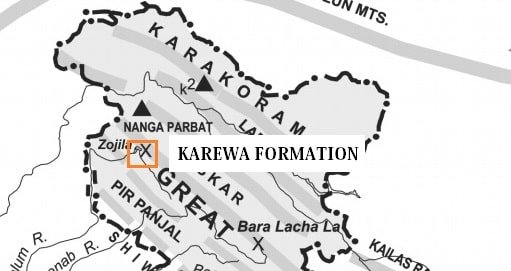Karewa formation has a link with the Kashmir Himalayas. these are lacustrine deposits of Plio Pleistocene age.
Karewa formation: The term “Karewa”
In the Kashmiri dialect, the term Karewa means “elevated table land”. Firstly, this term was used by Godwin Austin in 1859 and later on by Lydekker in 1878 for unconsolidated to semi-consolidated sand clay conglomerate sequence.
“Vudr” is the local name for Karewas in Kashmiri language.
What is Karewa formation?
Karewas are the thick deposits of glacial clay and other materials embedded with moraines. These are unconsolidated lacustrine deposits. Lacustrine means “associated to lakes”.

Kashmir valley resides between the Great Himalayas and the Pir Panjal ranges of the Kashmir Himalayas. In earlier times, when the upliftment of the Pir Panjal ranges happened, the flow of the river has stopped.
As a result, the whole of Kashmir valley became a large lake. Slowly, the glacial deposits have accumulated here in this lake. Thus creating a large lacustrine plain.
Later on, the water drained away and these unconsolidated deposits remained there. These unconsolidated gravel and mud deposits are known as Karewa formation.
However, some beliefs also say that the water accumulation was of Tethys sea. and over time, many earthquakes came. As a result, some fault developed in the Baramulla range and the water drained out.
The depth of Karewa deposits is about 1400 m and most of the area lies to the west of the river Jhelum.
Economic significance of Karewas
Karewa deposits have different soil and sediments such as sand, clay, silt, shale, mud, lignite and losses. Hence, these are very useful for agricultural and horticulture activities.

Karewa formations are useful for the cultivation of Zafran. Zafran is a local variety of Saffron in Kashmir valley. These are also important for the cultivation of almond, walnut, apple, and orchards.